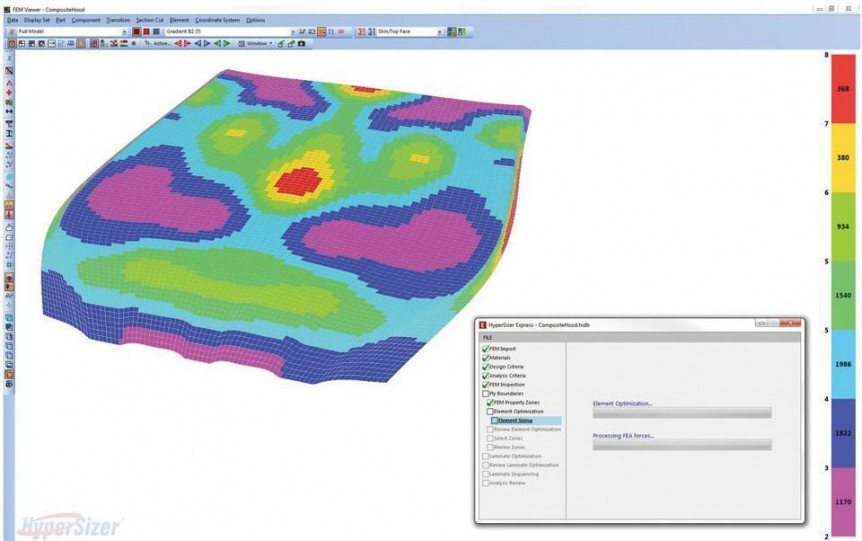Posted on 10/4/2016
Source: Automotive Design & Production,
Lawrence S. Gould , Contributing Editor
Although this software has its genesis at NASA, a new version of HyperSizer helps automotive engineers create lightweight composite part designs.

Terms such as “reduce weight,” “weight savings” and “minimum weight” are ingrained in the aircraft and aerospace industries. Let’s face it: they build vehicles that fly, so mass is critical. The auto industry is now going in a similar direction—not vertically, but in terms of mass reduction, in order to meet fuel economy and emissions regulations the world over.
The aircraft industry has largely transitioned from metal parts and structures to long-fiber composite materials to satisfy its lightweighting needs. Case in point: Nearly half of the airframe for the Boeing 787 is made of carbon fiber reinforced plastic and other composites. In automobiles, metal and plastic still predominate. But that’s changing. “We’ve talked to automotive about selecting hybrid-material composites, and putting long continuous fibers in certain automotive parts for stiffness,” says Craig Collier, founder and president of Collier Research Corp. (hypersizer.com). By “hybrid,” he means fiber and metal.
Pro as benchmark
HyperSizer, Collier Research’s flagship product, is computer-aided engineering (CAE) software that began at NASA nearly 30 years ago. On average, it reduces structural weight 20-40 percent by letting designers and engineers try different composites and orientations, virtually place parts under virtual loads, and see where stresses exist on those parts. This process starts by importing a finite element model (FEM) and the stress results from finite element analysis (FEA) into HyperSizer, then choosing a material, selecting the analyses (failure theory, such as max strain or Tsai Wu), and defining the design criteria (such as layup rules, symmetry and balance and fabrication preferences) and safety factors.
HyperSizer does the rest while showing the optimization process in 3D. Note that HyperSizer does not perform FEA. Instead, it works with mainstream FEA software (e.g., Abaqus, Ansys, Nastran and OptiStruct) to iteratively update the FEM in FEA with data from the HyperSizer-optimized design until the laminate design meets load requirements. The software creates the ply shapes layer by layer, and the entire sequence of plies can be exported to spreadsheets for import into computer-aided design systems.
Users can draw a cut-plane on the FEM and visualize a 2D section cut; view ply coverage, and the shape and size of each ply layer; and plot ply drops, adds and counts. Users can also try different FEM property zones for additional weight savings.
Plug-ins can integrate HyperSizer with existing analysis methods and legacy codes. A component object model (COM) interface lets users run HyperSizer from Excel, Matlab and other programs, as well as integrated environments such as ModelCenter and Isight.
For lightweighting, according to Collier Research, HyperSizer “performs sizing optimization to determine the lightest weight combination of material systems and cross sectional geometric dimensions (panel height, stiffener spacing, etc.) including layup ply angles and stacking sequences. Laminate optimization includes real-world manufacturing constraints that ensure designs are manufacturable by minimizing ply drops across sizing component boundaries and identifying and reducing the number of ply part numbers and process steps.” This optimization “involves surveying millions of candidate dimensions and laminates, finding the optimum variables down to the ply level.”
“Express” is no slouch
HyperSizer Pro is the FEA package Collier Research targets to the aircraft and aerospace industries. Says Collier, “It has a lot of extra features. Unfortunately, with that comes extra ‘dials’ you need to turn—dials that the automotive-specific user does not want to see.” Last April, the company released HyperSizer Express. Pro and Express are 100 percent compatible; their databases are interchangeable.
HyperSizer Express’s relevance to automotive goes beyond “dials” and interface. In fact, there are optimization algorithms in Express not found in the Pro product. For example, Express includes stiffness optimization algorithms targeted to automotive. The Express version is also aware of automotive manufacturing methods. This is important because manufacturing automotive parts and structures out of long continuous composite fibers, says Collier, are more challenging to make; it’s not like stamping out sheet metal parts. Such awareness, he says, “translates to reduced manufacturing costs.”
As with Pro, the optimization uses all of the FEA computed shell element in-plane membrane forces, out of plane transverse shear forces, and bending moments. These result in ply fiber, transverse to fiber and shear direction stresses. Engineers can include FEA solver iterations for static, buckling and frequency runs. Express satisfies all strength and closed form buckling failure criteria during optimization. It can also extract FEA eigenvalue solutions and identify elements needing stiffening. Users can also identify displacement limits for any grid in the FEM.
Engineers can select from several different failure criteria. Ply-based failures include max strain, max stress, quadratic methods (e.g., Tsai Hahn), and physically based methods (e.g., Hashin and Puck 2D and 3D). Laminate-based aerospace damage tolerance criteria are also provided, such as open hole compression, compression after impact and barely visible impact damage. Metal analyses include Von mises yield and max principal stress.
Express handles the lightweighting of both metal and composite designs, even though the physics are “completely different,” says Collier. Metals, for instance, exhibit plastic properties (malleability and brittleness); composites are more brittle; and the failure modes of both materials are different. A user can select either material systems—or both. “Having both physics in your software at a core level,” continues Collier, “allows you to consider hybrid materials systems and to analyze the tradeoffs between materials in those systems.”
And therein lies a critical message. “Optimization has become an essential tenet of engineering,” concludes Collier, “but there are still so many people out there who are not doing any optimization.”

http://www.adandp.media/articles/lightweighting-special-coverage-software-for-lightweighting-composite-parts
